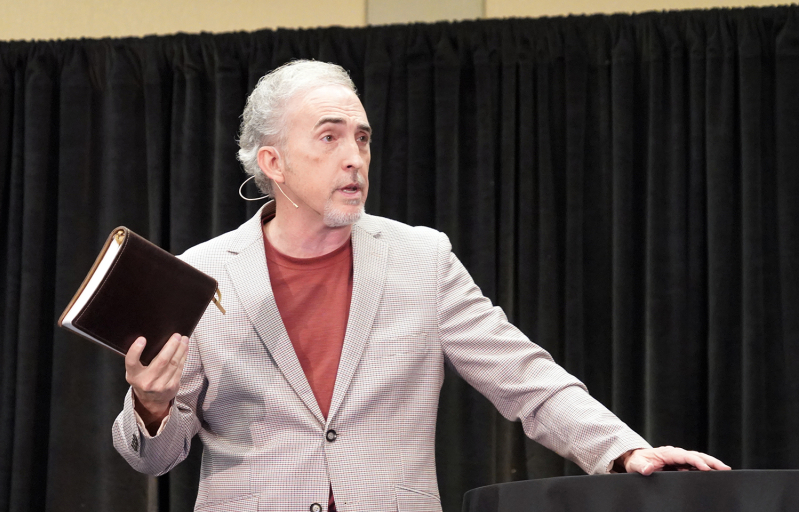
In a captivating keynote address at the Evangelical Press Association’s annual convention, Dr. Mark Yarbrough, president of Dallas Theological Seminary, urged Christian writers and communicators to frame their work within the full, sweeping narrative of Scripture—from creation to new creation.
Speaking to some 200 attendees at the Hilton Convention Center in Branson, Missouri, Yarbrough delivered a one-hour presentation drawn from his signature course, The Story of Scripture, a 13-week class that Dallas Theological Seminary (DTS) offers free online to the public. The course provides a structured overview of the Bible, its literary components, and how every passage ultimately points to the redemptive work of Christ.
“Your work as Christian communicators is more important now than ever,” Yarbrough told the audience of editors, authors, and journalists. “We cannot miss our moment. We are called to tell the story—the greatest story ever told—and to help people see where they fit within it.”
Understanding the structure of Scripture
At the heart of Yarbrough’s message was a plea to recover the Bible’s master narrative. Using a memorable cadence—“5-12-5-5-12, 4-1-21-1”—he walked the audience through the English Bible’s structure: five books of law, 12 of history, five of poetry, five major prophets, 12 minor prophets, four gospels, one book of history (Acts), 21 letters, and one book of prophecy (Revelation).
“Many believers grow up hearing isolated sermons or topical series. It’s like they’re collecting puzzle pieces without ever seeing the box top,” he said. “But the Bible is not a random collage. It’s a unified narrative, and as communicators, it’s our task to help people grasp the big picture.”
Yarbrough emphasized that the Bible’s structure is not merely academic. It reflects a divine storyline that begins with creation, unfolds through covenants and kings, climaxes in the person of Jesus, and culminates in the renewal of all things.
From creation to covenant
Tracing the Bible’s storyline from Genesis to Revelation, Yarbrough described how each major section of Scripture builds upon God’s covenant promises. He began with the creation narrative in Genesis 1–2, where God makes male and female in His image, and moved swiftly to the fall in Genesis 3, where sin enters the world, which overshadows the entire history to this day. However, the Genesis narrative also sets the stage for redemption.
“Every human being knows something is broken,” he said. “They may not describe it as Genesis 3, but they’re trying to get back to Eden. That’s why our story resonates so deeply.”
He then unpacked the Abrahamic Covenant in Genesis 12, calling it the hinge of the Old Testament narrative. “God reveals Himself as a covenant-making God. Abraham is not the solution—God’s character is,” Yarbrough said. “And Jesus is the fulfillment of that solution.”
The story continued with the Mosaic Covenant, the giving of the Law at Sinai, and Israel’s repeated failure to keep it. Yarbrough stressed the distinction between the unconditional nature of God’s covenant with Abraham and David, and the conditional nature of the Mosaic Covenant.
“There has never been another ethnically identifiable group with a law and no land,” he said. “But even when Israel broke the covenant, God remained faithful to His promise.”
The coming King and the new covenant
Yarbrough highlighted the Davidic Covenant as the foundation for the messianic expectation that threads through the rest of the Old Testament. “God promises David a royal line that will never end—a king who will rule forever,” he said. “That king is Jesus.”
During Israel’s darkest days, Yarbrough noted, the prophet Jeremiah announced a fourth covenant—the New Covenant. This promise would not be written on stone but on human hearts, offering true forgiveness and a restored relationship with God.
“The New Covenant is what Jesus referred to at the Last Supper,” Yarbrough said. “It is central to our understanding of salvation, and it’s what our readers need to know today.”
A narrative that centers on Christ
Drawing from the Gospels, Acts, the epistles, and Revelation, Yarbrough showed how the New Testament completes the biblical narrative.
“Jesus didn’t come to abolish the Law—He came to fulfill it,” Yarbrough said. “The Gospels show us who He is. Acts shows us what happens when the story is shared. The letters teach us what Christians believe and how we live. And Revelation shows us how the story ends—with God dwelling among His people forever.”
He described Revelation as “a colorful, victorious picture” of God defeating evil, reversing the curse, fulfilling His covenants, restoring creation, and establishing eternal fellowship with His people.
A calling for communicators
Throughout the address, Yarbrough returned to the responsibility of Christian communicators to tell this story with clarity and conviction.
“Lord, forgive us for every time we gripe about a deadline,” he said. “We have the privilege of communicating the greatest news the world has ever known. Let’s do it well.”
He challenged attendees to hold fast to historic Christian orthodoxy—truths the church has always believed, including the inspiration of Scripture, the Trinity, the deity and humanity of Jesus, salvation by grace through faith, and Christ’s return.
“These are the non-negotiables,” he said. “In all the work we do—writing, editing, publishing—we must reflect and reinforce the story we’ve been given.”
Yarbrough concluded with a call to joy and urgency. “We know the end of the story. But the good news is only good news if it gets to people before the bad news. So let’s go out and tell the whole story—faithfully, beautifully, boldly.”





